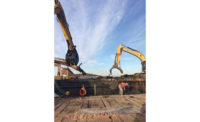"We don't do anything on our own anymore," emphasizes Denver's City Engineer and Deputy Director of Public Works Lesley Thomas, who serves tens of thousands of new Mile High City residents a year. The city is partnering with the U.S. Army Corps of Engineers to rebuild streets and bikeways, Colorado Dept. of Transportation to reconstruct highways and the Rapid Transportation District to build bus and train routes.
The theme of collaborative budget-bartering continues in Reno. Nevada's Director of Public Works, John Flansberg, says: "Reno is rebuilding a shared water treatment plant with the city of Sparks. Reno and Sparks are sharing the burden of providing bedrooms, classrooms and fire and police protection for Storey County. Storey County's literally moving mountains to build a manufacturing center that's providing jobs for residents of Reno and Sparks." Case in point is Tesla Motors, which is building a major battery factory under the supervision of Storey County's Community Development Dept. Director Dean Haymore.
ENR's "Low & Slow" tour ended in San Francisco, host to a great number of public-works projects. "A creative culture around the city's construction projects is generating a synergy that's feeding on itself," reflects Fuad Sweiss, San Francisco's city engineer and former public works director for Oakland.
The range of projects, from the construction of a future high-speed rail station to the resurfacing of 900 city blocks a year, represent infrastructure's critical role as both commuter routes and lifelines in case of an earthquake.
"Ultimately every curb, pipe and wire in San Francisco is critical infrastructure," explains Mayor Edwin Lee (D), previously the head of the city's DPW. "Political leaders at every level of government are facing a steepening learning curve in managing these vital urban systems. It's simple: The right infrastructure is paramount in serving a growing San Francisco and Bay Area."




